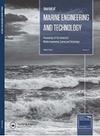Residual strength prediction and structural response of a multi-chamber cabin to a fire
IF 4.4
4区 工程技术
Q1 Engineering
Journal of Marine Engineering and Technology
Pub Date : 2023-07-10
DOI:10.1080/20464177.2023.2233264
引用次数: 1
Abstract
In this study, the fire safety of a ship structure is evaluated using a fire dynamics algorithm for large eddy simulations and a structural-thermal coupling method. Taking a two-story cabin as an example, a typical I-channel is adopted and the fire-thermal-structure coupling calculation of the cabin is realised through a thermal-mechanical coupling data interface. On this basis, the failure characteristics, stress distribution, and deformation modes of the cabin under different heat release rate (0–8 MW) and fire locations (side and middle chambers) are studied. The results show that an increase in the heat release rate in the side chamber causes the failure path of the cabin to gradually expand from the fire-source side to the sagging plane. This differs from the failure mode of the cabin in the sagging plane at ambient temperature. When a high-power fire occurs in the middle chamber of the cabin, its spatial layout significantly influences the damage location. Moreover, the residual strength of the cabin at different fire positions in a heat release rate range of 0–8 MW is predicted.火灾下多室舱室剩余强度预测及结构响应
在本研究中,采用大涡模拟的火灾动力学算法和结构-热耦合方法评估了船舶结构的火灾安全性。以某两层客舱为例,采用典型的i型通道,通过热-力耦合数据接口实现客舱的火-热-结构耦合计算。在此基础上,研究了不同放热速率(0 ~ 8 MW)和火灾位置(侧室和中室)下舱室的破坏特征、应力分布和变形模式。结果表明:侧室放热速率的增大,使舱室的失效路径从火源侧逐渐向下沉面扩展;这不同于在环境温度下飞机下沉时客舱的失效模式。当大功率火灾发生在机舱中部时,其空间布局对损伤位置有显著影响。在0 ~ 8 MW的放热速率范围内,预测了不同火灾位置下舱室的剩余强度。
本文章由计算机程序翻译,如有差异,请以英文原文为准。
求助全文
约1分钟内获得全文
求助全文
来源期刊

Journal of Marine Engineering and Technology
工程技术-工程:海洋
CiteScore
5.20
自引率
0.00%
发文量
0
审稿时长
>12 weeks
期刊介绍:
The Journal of Marine Engineering and Technology will publish papers concerned with scientific and theoretical research applied to all aspects of marine engineering and technology in addition to issues associated with the application of technology in the marine environment. The areas of interest will include:
• Fuel technology and Combustion
• Power and Propulsion Systems
• Noise and vibration
• Offshore and Underwater Technology
• Computing, IT and communication
• Pumping and Pipeline Engineering
• Safety and Environmental Assessment
• Electrical and Electronic Systems and Machines
• Vessel Manoeuvring and Stabilisation
• Tribology and Power Transmission
• Dynamic modelling, System Simulation and Control
• Heat Transfer, Energy Conversion and Use
• Renewable Energy and Sustainability
• Materials and Corrosion
• Heat Engine Development
• Green Shipping
• Hydrography
• Subsea Operations
• Cargo Handling and Containment
• Pollution Reduction
• Navigation
• Vessel Management
• Decommissioning
• Salvage Procedures
• Legislation
• Ship and floating structure design
• Robotics Salvage Procedures
• Structural Integrity Cargo Handling and Containment
• Marine resource and acquisition
• Risk Analysis Robotics
• Maintenance and Inspection Planning Vessel Management
• Marine security
• Risk Analysis
• Legislation
• Underwater Vehicles
• Plant and Equipment
• Structural Integrity
• Installation and Repair
• Plant and Equipment
• Maintenance and Inspection Planning.
 求助内容:
求助内容: 应助结果提醒方式:
应助结果提醒方式:


